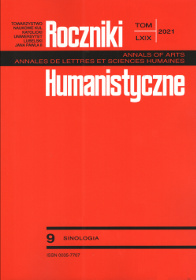Between Sound and Voice: Teaching Chinese Tones To Non-Tonal Language Speakers
Abstract
The production of highly intelligible syllables in Mandarin Chinese entails a successful production of tones, which poses a challenge for learners of Chinese as a foreign language. The aim of the current paper is to address this issue by identifying the key tonal features contributing to tone intelligibility in the lexemes produced by Polish learners of Mandarin Chinese as a foreign language. Samples of Polish female students’ tonal pronunciations at two stages of learning were selected and compared with productions made by a female native speaker of Mandarin Chinese from Taiwan. Four syllables produced by the students were selected from a corpus of read-out passages which had already been assessed for the intelligibility of monosyllabic lexemes by native judges. The students’ pronunciation samples (whose pronunciation improved from the A1 minus language level to A2) were analysed using pitch, fundamental frequency contour, and register span criteria, and then compared to the female native speaker’s pronunciations of the same syllables. Importantly, before the results of this analysis are presented, the simplified model of tones widely used in language instruction is compared and contrasted with the acoustic analysis of tonal productions made by the native speaker. This is done to show to what extent the simplified, widely used model reflects real-life tonal productions.
References
Boersma, Paul, and David Weenink. 2021. Praat: doing phonetics by computer [Computer program]. Version 6.1.40, retrieved 27 February 2021 from www.praat.org/. Accessed 14.11.2021.
Boersma, Paul, and David Weenink. “Speak and unSpeak with Praat.” Glot International, vol. 5 (9/10), 1996, pp. 341-347.
Boersma, Paul. “Praat, a system for doing phonetics by computer.” Glot International, vol. 5, 2001, pp. 341 345.
Chang, Yung-hsiang Shawn. Distinction between Mandarin Tones 2 and 3 for L1 and L2 Listeners. Jing-Schmidt, Zhuo (ed.). Proceedings of the 23rd North American Conference on Chinese Lingusitics (NACCL-23). Vol. 1. University of Oregon, 2011, pp. 84-96.
Chao, Yuen Ren. A Grammar of Spoken Chinese. University of California Press, 1968.
Chen, G. T. “The Pitch Range of English and Chinese Speakers.” Journal of Chinese Linguistics, vol. 2, no. 2, 1974, pp. 159-171.
“Fundamental Frequency, Pitch, F0.” Stan Z. Li, and Anil Jain, editors. Encyclopedia of Biometrics. Springer, 2009. Doi: 10.1007/978-0-387-73003-5_775; link.springer.com/referenceworkentry/ 10.1007%2F978-0-387-73003-5_775. Accessed 10.03.2021.
Hirose, Keikichi, Qinghua Sun, and Nobuaki Minematsu. “Synthesis of fundamental frequency contours for standard Chinese based on superpositional and tone nucleus models.” Archives of Acoustics, vol. 32, no. 1, 2007, pp. 41-50.
Howie, J.M. “On the Domain of Tone in Mandarin.” Phonetica, vol. 30, 1974, pp. 129-148.
Jeng, Jing-Yi (鄭靜宜), Gary Weismer, and Raymond D. Kent. “Production and perception of mandarin tone in adults with cerebral palsy.” Clinical Linguistics & Phonetics, vol. 20, issue 1), pp. 67-87.
Jeng, Jing-Yi (鄭靜宜). 語音聲學:説話聲音的科學 [Yuyin shengxue: Shuohua shengyin de kexue]. 心理出版社 [Xinli chuban she]. 心理 [Xinli], 2011.
Li, Charles N., & Sandra A. Thompson. Mandarin Chinese. A Functional Reference Grammar. University of California Press, 1989.
Li, Xiao Qi (李晓琪), editor. Boya Chinese: Elementary (1) [博雅汉语 1] [Boya hanyu 1]. 北京大学出版社 [Beijing daxue chuban she], 2004, 2013.
Lu, Jianyi (魯健骥) et al., editors. Modern Chinese Beginner’s Course 1-2 [初级汉语课本] [Chuji hanyu keben]. 北京语言大学出版社 [Beijing yuyan daxue chuban she], 1986, 1994.
NTNU MTC. Practical Audio-Visual Chinese (1) [實用視聽華語 (1)] [Shiyong shiting huayu (1)]. 正中書局 [Zhengzhong shuju], 1999, 2008, 2017.
Sheng Hwa (盛華 Sheng Hwa Chen). “Voice range profile of Taiwanese normal young adults: a preliminary study.” 聽語會刊 [Ting yu hui kan], 12, 1996, pp. 79-86.
Sielska-Badurek, Ewelina, and Anna Domeracka-Kołodziej. “Rola podparcia oddechu w śpiewie operowym.” Otolaryngologia, vol. 8, no. 3, 2009, pp. 109-114.
Tseng, Chiu-yu. An acoustic phonetic study on tones in Mandarin Chinese. Institute of History & Philology Academia Sinica. Special Publications No. 94, 1990.
Wang, Yue, Joan A. Sereno, and Allard Jongman. “L2 Acquisition and Processing of Mandarin Tone.” Ping Li, Li Hai Tan, Elizabeth Bates, and Ovid J. L. Tzeng. The Handbook of East Asian Psycholinguistics. Vol. 1. Cambridge University Press, 2006, pp. 250-256.
Xu, Yi. “Contextual tonal variations in Mandarin.” Journal of Phonetics, 25, 1997, pp. 61-83.
Zajdler, Ewa, and Chu Man-ni (朱曼妮). “How Polish Students Develop Mandarin Pronunciation through Intensive Training.” Applied Linguistics Papers, vol. 26, no. 2, 2019, pp. 103- 115.
Zajdler, Ewa. Glottodydaktyka. Wydawnictwo Akademickie Dialog, 2010.
Copyright (c) 2021 Roczniki Humanistyczne

This work is licensed under a Creative Commons Attribution-NonCommercial-NoDerivatives 4.0 International License.





